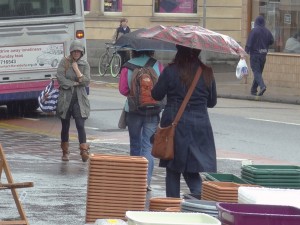 Market trading has existed for centuries and in many respects it hasn’t changed very much. One thing that has developed is the means of exchange. Goods used to be traded for other goods – for example 1 pig for 4 chickens! But then money was developed as a means of exchange and then came cheques and plastic.
Market trading has existed for centuries and in many respects it hasn’t changed very much. One thing that has developed is the means of exchange. Goods used to be traded for other goods – for example 1 pig for 4 chickens! But then money was developed as a means of exchange and then came cheques and plastic.
However, for many market traders, accepting credit and debit cards is relatively costly. It involves paying a monthly contract, which for many traders is simply not worthwhile, based on the quantity and value of the transactions. But, for many customers using debit or credit cards is the preferred method of payment and the fact that some traders only accept cash can be a deterrent to them making purchases and this therefore reduces the sales of the market traders.
 But, with advances in technology a new way of paying has emerged. Small card readers can now be plugged into iphones, ipads, other tablets and smartphones. By putting a customer’s card into this device customers can then pay by card and either sign for their purchase or use the phone to enter their security details. There are plan for these companies to offer chip and pin technology to further ease payment by card on market stalls. The traders pay a small commission per transaction, but aside from that, the initial start-up cost is minimal and it is likely to encourage more customers to use markets. Jim Stewart, the Director of a firm that has begun using this technology said:
But, with advances in technology a new way of paying has emerged. Small card readers can now be plugged into iphones, ipads, other tablets and smartphones. By putting a customer’s card into this device customers can then pay by card and either sign for their purchase or use the phone to enter their security details. There are plan for these companies to offer chip and pin technology to further ease payment by card on market stalls. The traders pay a small commission per transaction, but aside from that, the initial start-up cost is minimal and it is likely to encourage more customers to use markets. Jim Stewart, the Director of a firm that has begun using this technology said:
I think it’s definitely going to take off, the world is going that way … The money has always appeared in my bank account, no transactions have been declined, my accountant is happy, it’s all been good.
Some customers have raised concerns about the security of these transactions, as they have to put their cards into someone else’s ipad. However, traders have said that there are no risks and that customers can be sent a receipt for their purchase. The following few articles look at this latest (and other) technological developments.
Smartphone card payment system seeks small firms BBC News, Rob Howard (19/1/13)
POS Trends: What’s new for 2013 Resource News (17/1/13)
Payments by text message service to launch in UK in Spring 2014 BBC News (15/1/13)
Questions
- What are fixed cost and why does having a traditional card payment machine represent a fixed cost for a firm?
- How might this new technology affect a firm’s sales and profits?
- Will there be an increase in the firm’s variable costs from adopting this technology?
- Using a cost and revenue diagram, put your answers to questions 1 – 3 into practice and show how it will shift them and thus how the equilibrium may change for a market trader.
- What are the properties of money that allow it to be a good medium of exchange?
- How will this increased use of debit and credit cards affect the demand for money? Use a diagram to illustrate your answer.
 Weather has already been partly blamed for poor economic growth, in particular in December 2010 and January 2011. April 2012 is no different – the wettest April on record is said to have caused the worst performance in sales since March 2011.
Weather has already been partly blamed for poor economic growth, in particular in December 2010 and January 2011. April 2012 is no different – the wettest April on record is said to have caused the worst performance in sales since March 2011.
Like-for-like sales fell by 3.3%, mainly through lower demand for clothes and shoes. Supermarkets saw an increased demand for warmer food items with the colder weather and demand for home products also increased, with analysts suggesting that people decided to re-decorate their houses rather than venture outside! This was further supported by sales of gardening equipment, which also fell. However, the weather is not always bad – in March, sales were higher than expected, with the unusually warm weather, but unfortunately for growth statistics, the boost in sales in March has been more than offset by the decline in sales in April. Furthermore, there are concerns that the March ‘heat-wave’ may have encouraged consumers to do their summer shopping already and hence summer sales may suffer.
The retail data for April 2012 must be considered carefully, as comparing this month’s sales with the same period last year will be very misleading. Last April, the UK was hit with the Royal Wedding, which did boost sales of many products – underlying sales growth was recorded at 5.2% for the month. However, whilst April sales for 2012 could hardly hope to compete with April sales for 2011, the downward trend is undoubtedly going to cause concern for the government. Helen Dickinson, Head of Retail at KPMG said:
“While May will certainly be brighter than April, the health of the retail sector continues on a downward trajectory.”
Whether or not sales do continue their downward trend depends on many factors, including government policy measures to boost growth and cut unemployment. However, one other variable that may influence the trend is the weather. Here’s hoping that the sun shines and people begin to spend!
Weaker retail sales, job surveys raise risk of longer slump Reuters, Olesya Dmitracova (9/5/12)
Wettest April ‘hits retail sales’ BBC News (9/5/12)
Retail sales slide in wettest April on record Telegraph (9/5/12)
April showers wash out retail sales Financial Times, Sarah O’Connor (9/5/12)
Retail sales slip back 1 per cent as fashion stores weather April showers Independent, James Thompson (9/5/12)
Questions
- Use a demand and supply diagram to illustrate the effects of the weather on equilibrium price and output.
- What other factors besides the weather affect retail sales?
- What government policy measures could be implemented to try to boost the retail sector?
- From the information you are told are there any sectors that surprise you in terms of whether sales have risen or fallen? Explain your answer in each case.
- With sales in April falling, what is the implication for a firm’s profits? What steps might a firm take in a bid to boost sales?
 Is Google’s Android catching up with Apple’s iOS in the market for apps? With Android tablets and smartphones taking an ever larger proportion of the market, you would expect so. In the third quarter of 2011, 53% of smartphone shipments used Google’s Android system, compared with only 15% with iOS.
Is Google’s Android catching up with Apple’s iOS in the market for apps? With Android tablets and smartphones taking an ever larger proportion of the market, you would expect so. In the third quarter of 2011, 53% of smartphone shipments used Google’s Android system, compared with only 15% with iOS.
However, Apple is still ahead of Google in the share of apps downloads. To date, there have been 18 billion downloads from the iOS App Store for iPhone, iPad and iPod Touchs compared with 10 billion downloads of Android apps. But Android downloads are growing faster and are set to overtake those of iOS apps in the coming months. This should be boosted with the new Ice Cream Sandwich Android operating system.
But what about revenues earned from downloads? Here the picture is very different. Android Marketplace has earned around $330 million gross revenue for paid apps. Apple’s App Store, by contrast, has earned over 15 times as much: nearly $5000 million. The reason is that 99% of Android apps are free; the figure for App Store apps is 86%. But why is this so and how can Android earn revenues from its apps? And how can app developers earn revenues from the Android market? The following articles look at the economics of apps.
Android Vs. iPhone: The Economics Of Apps Financial Edge, Manish Sahajwani (6/1/12)
Google has an Amazon problem MSN Money, Jim J. Jubak (25/1/12)
Android and the economics of apps BBC News, Rory Cellan-Jones (7/12/11)
Apple Getting Best Of The Android Vs. iPhone Economics Forbes, Manish Sahajwani (6/1/12)
Fragmentation Is Not The End of Android cek.log, Charlie Kindel (14/1/12)
Questions
- Why are most Android apps free to download?
- What is the business model for (a) developing and (b) offering Android apps?
- How can money be made from free apps?
- What are the long-term strengths and weaknesses in Apple’s apps business model?
- Assess Amazon’s business model for apps for Kindle users.
With Christmas approaching, many high street stores will be hoping for a big increase in sales, but that seems unlikely to be enough for Arcadia, whose brands include Top Shop, BHS and Dorothy Perkins. Arcadia’s profits have decreased to £133m, which is a fall of 38% and, based on this data, it is planning on closing many stores across the country over the next few years. With leases expiring on many of their stores within about 3 years, the current plan, according to Sir Phillip Green, is to close about 250 stores. Speaking to the BBC, he commented:
‘Now, there may be other opportunities that turn up that we might want to open. But certainly, in terms of our existing portfolio, currently that’s our thinking.’
The economic climate has obviously played a key role, but so has the weather. With the hottest October and November for decades, people have been delaying their shopping and purchases of winter clothing and this has put increased strain on many high street traders (see the news item Dreaming of a white Christmas).
What is perhaps of more concern than one company’s profits being significantly lower is the impact this may have on unemployment. With over 2500 stores, Arcadia is one of the largest private employers in the UK and if 250 stores are closed, there may be severe consequences for the labour market and this may have further adverse effects on aggregate demand. A key factor that may partly determine the future of firms such as Arcadia is how much consumers spend this Christmas. Perhaps for these stores, they really may be hoping for a white Christmas – at least that may encourage people to stock up on winter clothes – if they can get to the shops!
Arcadia to close stores after reporting loss Financial Times, Andrea Felsted (24/11/11)
 Arcadia and Dixons post profit loss BBC News (19/4/10)
Arcadia and Dixons post profit loss BBC News (19/4/10)
Retail slowdown hits Arcadia stores Guardian, Zoe Wood (9/5/11)
Arcadia set to close up to 260 stores as profits fall BBC News (24/11/11)
Has Sir Phillip Green lost his Midas touch? Independent, James Thompson (25/11/11)
Arcadia suffers 40% slide in profits The Press Association (24/11/11)
Questions
- Explain why the current economic situation has caused a slowdown in retail sales.
- Illustrate the way in which a firm will maximise profits. If profits are declining, is it because sales revenue has fallen or that costs have risen? Adapt your diagram to show a fall in profits based on your answer.
- According to the article by the Press Association, margins were ‘squeezed by 1.8% as it took a £53 million hit to absorb price increases’. What does this mean?
- How might the unseasonably warm weather be an explanation for a weaker trading environment?
- If 260 stores are closed, what impact might this have on unemployment?
- If more workers lose their jobs, how might this have a subsequent adverse effect on sales? Think about the multiplier effect here.
Families in the UK seemed to have been squeezed in all areas. With incomes flat, inflation rising, petrol and bills high, there seems to be a never ending cycle of price rises without the corresponding increase in incomes. This has been confirmed by the latest figures released from the big six energy companies, whose profit margins have risen from £15 per customer in June to £125 per customer per year. This is assuming that prices remain the same for the coming year.
The regulator, Ofgem has said that profit margins will fall by next year and that they are ensuring that price comparisons between the big energy companies become much easier to allow consumers to shop around. It is a competitive market and yet due to tariffs being so complicated to understand, many consumers are simply unable to determine which company is offering them the best deal. There is certainly not perfect knowledge in this market. Tim Yeo, the Chair of the Energy and Climate Change Committee said the profit margins were:
‘Evidence of absolutely crass behaviour by the energy companies, with a jump in prices announced in the last few months ahead of what will be a winter in which most families face their highest ever electricity and gas bills’
Ofgem will publish proposals later this year with suggestions of how to make the market more competitive. We have already seen in the blog “An energetic escape?” how Ofgem is hoping to reduce the power of the big six by forcing them to auction off some of the electricity they generate. The aim is to free up the market and allow more firms to enter. With the winter fast approaching and based on the past 2 years of snow and cold weather, it is no wonder that households are concerned with finding the best deals in a bid to reduce just one of their bills. The following articles consider this issue.
Energy price hikes see profits soar The Press Association (14/10/11)
Energy suppliers’ profit margins eight times higher, says regulator Ofgem Telegraph (14/10/11)
Energy firms’ profit margins soar, Ofgem says BBC News (14/10/11)
Energy firms’ profits per customer rise 733%, says Ofgem Guardian, Dan Milmo and Lisa Bachelor (14/10/11)
Regulator proposes radical change to energy market Associated Press (14/10/11)
Energy bills face overhaul in first wave of reform Reuters, Paul Hoskins (14/10/11)
Ofgem tells energy companies to simplify tariffs Financial Times, Michael Kavanagh (14/10/11)
You can’t shop around in an oligopoly Financial Times, William Murray (13/10/11)
Questions
- What type of market structure best describes the energy market?
- Of the actions being taken by Ofgem, which do you think will have the largest effect on competition in the market?
- Are there any other reforms you think would be beneficial for competition?
- Why is transparency so important in a market?
- What barriers to entry are there for potential competitors in the energy market?
- Why do you think profit margins are so high in this sector?
 Market trading has existed for centuries and in many respects it hasn’t changed very much. One thing that has developed is the means of exchange. Goods used to be traded for other goods – for example 1 pig for 4 chickens! But then money was developed as a means of exchange and then came cheques and plastic.
Market trading has existed for centuries and in many respects it hasn’t changed very much. One thing that has developed is the means of exchange. Goods used to be traded for other goods – for example 1 pig for 4 chickens! But then money was developed as a means of exchange and then came cheques and plastic. But, with advances in technology a new way of paying has emerged. Small card readers can now be plugged into iphones, ipads, other tablets and smartphones. By putting a customer’s card into this device customers can then pay by card and either sign for their purchase or use the phone to enter their security details. There are plan for these companies to offer chip and pin technology to further ease payment by card on market stalls. The traders pay a small commission per transaction, but aside from that, the initial start-up cost is minimal and it is likely to encourage more customers to use markets. Jim Stewart, the Director of a firm that has begun using this technology said:
But, with advances in technology a new way of paying has emerged. Small card readers can now be plugged into iphones, ipads, other tablets and smartphones. By putting a customer’s card into this device customers can then pay by card and either sign for their purchase or use the phone to enter their security details. There are plan for these companies to offer chip and pin technology to further ease payment by card on market stalls. The traders pay a small commission per transaction, but aside from that, the initial start-up cost is minimal and it is likely to encourage more customers to use markets. Jim Stewart, the Director of a firm that has begun using this technology said:

